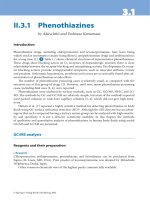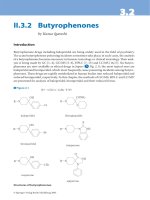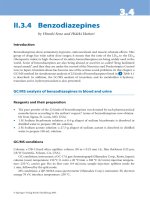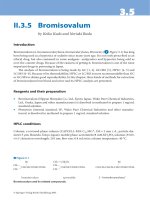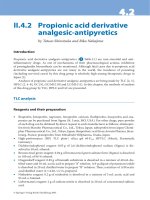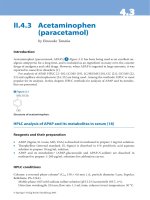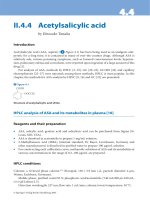Tài liệu Drugs and Poisons in Humans - A Handbook of Practical Analysis (Part 40) pdf
Bạn đang xem bản rút gọn của tài liệu. Xem và tải ngay bản đầy đủ của tài liệu tại đây (249.34 KB, 13 trang )
4.84.8
© Springer-Verlag Berlin Heidelberg 2005
II.4.8 Local anaesthetics
by Fumio Moriya
Introduction
Local anaesthetics reversibly block neural transmission in local tissues. e drugs are bound
with speci c receptors located inside the sodium channels of cell membranes, and thus block
the permeability of sodium ions; this is the mechanism of anaesthetic action of these drugs.
As the history of local anaesthetics, Von Anrep discovered the local anaesthetic action of an
alkaloid cocaine being contained in the leaves of Erythroxylon coca. en, Karl Koller used
cocaine as a local anaesthetic in ophthalmological surgery. Since the middle of 1980s, an explo-
sive abuse of cocaine appeared, because of its strong addictive e ects on the central nervous
system overwhelming the local e ects, causing a serious social problem internationally. In
place of cocaine, procaine appeared in 1905 as the rst synthetic local anaesthetic, followed by
the appearance of many synthetic drugs until nowadays.
Local anaesthetics can be classi ed into ester-type and amide-type drugs according to their
structures. Both types of the drugs di er in the mode of metabolism and chemical stability. e
ester-type local anaesthetics are easily hydrolyzed by the action of pseudocholinesterase in
blood plasma, and are also rapidly decomposed in alkaline solutions nonenzymatically. Am-
ide-type drugs are mainly metabolized by the liver microsomes and relatively stable in alkaline
solutions. Structures, physicochemical properties and clinical applications for cocaine and
other local anaesthetics being frequently used in Japan are summarized in
> Table 8.1
.
According to the literature [1] published by National Research Institute of Police Science,
Japan, seven fatal poisoning cases due to local anaesthetics were reported to have occurred in
1995–1999. e contents of the cases were: 4 cases of suicide by oral and intravenous adminis-
tration of lidocaine; one case each of medical accidents due to lidocaine, mepivacaine and
dibucaine. e local anaesthetics show relatively high incidence of anaphylactic shocks due to
their administration; dibucaine, lidocaine and procaine sometimes cause problems [2]. e
allergenicity observed for local anaesthetics are said to be mainly due to p-aminobenzoic acid,
the metabolite of the ester-type local anaesthetics, which has strong antigenicity as a haptene.
Such shocks due to the amide-type drugs and their metabolites are very rare; but p-oxybenzoic
acid being added to injection solutions as preservative may provoke the allergic reaction.
Local anaesthetics in biomedical specimens can be detected by various chromatographic
techniques [3–5]. Among them, GC analysis is most recommendable, because it is relatively
cheap and its handling and conditioning are simple; in addition, the use of the dual column
mode and selective detectors enables the screening of many kinds of drugs easily. In this chap-
ter, a method for simultaneous GC analysis of seven local anaesthetics listed in
> Table 8.1
and monoethylglycinexylidide ( MEGX), an active metabolite of lidocaine, is presented [6].
Local anaesthetics
⊡ Table 8.1
Structures, physicochemical properties and applications of local anaesthetics being widely used in
Japan
Compound Physicochemical properties Applications
Ester type
cocaine hydrochloride MW = 339.8
Colorless crystals or white powder;
highly soluble in water, easily soluble
in glacial acetic acid or ethanol,
slightly soluble in acetic anhydride
and almost insoluble in ether;
melting point: about 197° C.
Topical anaesthesia:
mucous membranes,
eye drops, and
external application
Ester type
tetracaine hydrochloride MW = 300.8
White crystals or powder; highly
soluble in formic acid, soluble in
water, slightly soluble in ethanol,
relatively insoluble in anhydrous
ethanol and almost insoluble in
ether; melting point: 148° C.
Spinal, epidural,
conduction,
infiltration and
topical anaesthesias
Ester type
procaine hydrochloride MW = 272.8
White crystals or powder; highly
soluble in water, slightly soluble in
ethanol and almost insoluble in
ether; melting point: 155–158° C.
Spinal, epidural,
conduction,
and infiltration
anaesthesias
Amide type
dibucaine hydrochloride MW = 379.9
White crystals or powder; highly
soluble in water, ethanol and glacial
acetic acid, soluble in acetic
anhydride and almost insoluble in
ether; hygroscopic; melting point:
95–100° C.
Spinal, caudal,
conduction,
infiltration and
topical anaesthesias
Amide type
bupivacaine hydrochloride MW = 342.9
White crystal; soluble in glacial acetic
acid, slightly soluble in water and
ethanol and almost insoluble in
acetic anhydride, ether and
chloroform; melting point: about
250° C
Epidural, conduction
and spinal
anaesthesias
Amide type
mepivacaine hydrochloride MW = 282.8
White crystal and powder; soluble in
water and methanol, slightly soluble
in glacial acetic acid, relatively insolu -
ble in anhydrous ethanol and almost
insoluble in ether; melting point:
about 256° C (decomposed)
Epidural, conduction
and infiltration
anaesthesias
Amide type
lidocaine hydrochloride MW = 288.8
White powder; highly soluble in
water and ethanol, slightly soluble in
chloroform and almost insoluble in
ether; melting point: 76–79° C.
Epidural,
conduction,
infiltration, topical
and spinal
anaesthesias,
ventricular
arrhythmia
378
379Local anaesthetics
Reagents and their preparation
• Cacaine hydrochloride and other local anaesthetics can be obtained from Sigma (St. Louis,
MO, USA). MEGX hydrochloride was donated by Astra Japan (Osaka, Japan).
• Methanolic solutions of local anaesthetics
a
: 10 mg of hydrochloride salt of each drug is dis-
solved in 100 mL methanol.
• Internal standard (IS) solution
a, b
: 2 mg of ketamine hydrochloride (Sigma) is dissolved in
100 mL methanol.
• Neostigmine bromide solution (0.05 µmol/mL)
c
: 15.2 mg neostigmine bromide (Sigma) is
dissolved in 100 mL puri ed water.
• 1 M Carbonate bu er solution (pH 9.7): 1 M sodium carbonate solution/1 M sodium
bicarbonate solution (7:2).
• 0.1 M Hydrochloric acid solution.
• Diethyl ether and isoamyl alcohol: special grade commercially available.
GC conditions
GC column
d
: a TC-5 wide-bore capillary column (5 % phenylmethylsilicone, 15 m × 0.53 mm
i. d., lm thickness 1.5 µm, GL Sciences, Tokyo, Japan).
GC conditions: a Shimadzu gas chromatograph (GC-14B, Shimadzu Corp., Kyoto, Japan);
detector: a ame thermionic detector ( FTD)
e
; column (oven) temperature: 150 °C (2 min)→
10 °C/min→ 300 °C (6.5 min); injection and detector temperature: 300 °C; carrier gas: He
f
( ow pressure 15 kPa).
Procedures
i. Body fluid specimens including blood
i. A 0.5-mL volume of a specimen and 1.5 mL of neostigmine bromide solution (0.05 µmol/
mL)
g
are placed in a test tube with a screw cap (16 × 130 mm with a round bottom) and
vortex-mixed for several seconds.
ii. A 100-µL aliquot of IS solution and 2 mL of the carbonate bu er solution (1 M, pH 9.7)
are added to the above mixture and vortex-mixed for several seconds, followed by the
addition of 8 mL diethyl ether.
iii. A er the tube is capped, it is gently
h
shaken for 25 min using a shaker and centrifuged at
3,000 rpm for 5 min.
iv. e upper organic layer is transferred to a new disposable centrifuge tube (16 × 125 mm,
with a round bottom) using a disposable polyethylene pipette
i
.
v. A 1-mL volume of 0.1 M HCl solution is added to the organic extract, vortex-mixed for
30 s and centrifuged at 3,000 rpm for 5 min.
vi. e upper organic layer is discarded by aspiration with an aspirator using a Pasteur
pipette.
vii. To the aqueous phase, 4 mL diethyl ether is added, vortex-mixed for 10 s and centrifuged
at 3,000 rpm for 5 min, followed by the second removal of the organic layer with the aspi-
rator.
380 Local anaesthetics
viii. To the aqueous phase, 1 mL of the carbonate bu er solution (1 M, pH 9.7) and 4 mL di-
ethyl ether are added, vortex-mixed for 30 s and centrifuged at 3,000 rpm for 5 min.
ix. e upper organic layer is transferred to a new disposable small test tube (12 × 100 mm,
with a round bottom) using a transfer pipette.
x. A er addition of 100 µL isoamyl alcohol to the organic layer, the latter is evaporated
down to about 100 µL
j
under a gentle stream of nitrogen on an aluminum heating block
at 50 °C.
xi. A er cooling the test tube to room temperature, 1 µL of isoamyl alcohol layer
k
is injected
into GC.
ii. Organ specimens
i. A 1-g aliquot of tissue and 3 mL of neostigmine bromide solution (0.05 µmol/mL) are
placed in a disposable test tube (16 × 100 mm, with a round bottom).
ii. e tissue is minced and homogenized using a homogenizer.
iii. A 2-mL volume of the homogenate is placed in a test tube with a screw cap, and the follow-
ing procedure is made according to the steps ii.–xi. for the above body uid specimens.
iii. Construction of calibration curves
i. Various volumes (1–20 µL) of methanolic solution (100 µg/mL) of each drug are placed in
more than 5 test tubes with screw caps. e solutions are evaporated to dryness under a
gentle stream of nitrogen
l
.
ii. A 2-mL volume of puri ed water
m
is added to each tube and vortex-mixed for several
seconds.
iii. e following procedure is conducted according to the steps ii.–xi. for the body uid speci-
mens.
Assessment of the method
i. Advantages of the method
e procedure is simple.
Organ specimens, together with body uid specimens, can be analyzed.
No extraction columns
n
are not necessary and the cost is cheap.
ii. Disadvantages of the method
Highly in ammable diethyl ether
o
is used in this method.
When the specimens to be analyzed are many, the time required for the extraction proce-
dure becomes long; in such a case, the organic solvent and bu er solution should be handled
using dispensers.
iii. Detection limits and reproducibility of the method
Limits of detection (S/N=3) from blood obtained by this method using GC-FTD are: 5 ng/mL
for lidocaine, mepivacaine, tetracaine and bupivacaine, 10 ng/mL for cocaine and dibucaine,
15 ng/mL for procaine and 20 ng/mL for MEGX.
e calibration curves with blood and water specimens were linear in the range of 0–4 µg/
mL with correlation coe cients of 0.995–0.999. e coe cient of a slope for a blood specimen
381
was similar to that for a water specimen, for each drug (> Table 8.2)
p
. e coe cients of
variation were satisfactory with the values of 0.01–16.5 %.
> Figure 8.1 shows gas chromatograms obtained from extracts of blank blood and blood
spiked with 4 µg/mL of each drug
q
.
Poisoning cases, and toxic and fatal concentrations
Lidocaine
e therapeutic concentrations of lidocaine are 2–5 µg/mL in blood plasma; at not lower
than 6–8 µg/mL, the toxic symptoms, such as mental derangement, vertigo, anxiety, delirium,
paresthesia, hypotension, CNS suppression and convulsion, may appear [7, 8]. Bromage and
Robson [9] reported the peak blood lidocaine concentrations of 9.0–14.0 µg/mL associated
with toxic symptoms for 4 subjects, who had been administered 425–1,000 mg of lidocaine by
intravenous drop infusion. Edgren et al. [10] reported blood lidocaine concentration of
19.2 µg/mL associated with insu ciency of heart muscle contraction and epileptic grand mal
for a 6-year-old child, who had been administered 1,200 mg lidocaine intravenously; but the
child could recover later.
When blood plasma lidocaine concentration exceeds 14 µg/mL, the possibility of fatality
becomes much higher [7]. In the cases of 5 adult patients, who had received intravenous ad-
ministration of 250–2,000 mg lidocaine and died several minutes a er, their blood lidocaine
concentrations were 6–33 µg/mL [11–13]. Grimes and Cates [14] reported blood lidocaine
⊡ Table 8.2
Calibration curves and CV values for local anaesthetics in blood and water
Drug Matrix Regression equation* CV value
(%, n=3)
lidocaine blood
water
y=0.268 x + 0.0262 (r=0.998)
y=0.264 x + 0.0135 (r=0.999)
0.01–4.86
0.77–3.63
MEGX blood
water
y=0.0528 x + 0.0004 (r=0.996)
y=0.0578 x – 0.0032 (r=0.999)
4.34–7.07
0.01–4.86
procaine blood
water
y=0.120 x – 0.0074 (r=0.995)
y=0.129 x – 0.0171 (r=0.997)
8.04–15.4
7.25–16.1
mepivacaine blood
water
y=0.190 x + 0.0155 (r=0.997)
y=0.194 x – 0.0003 (r=0.999)
2.90–5.61
0.81–3.46
cocaine blood
water
y=0.126 x + 0.0054 (r=0.998)
y=0.127 x – 0.0094 (r=0.999)
2.00–4.05
3.01–9.13
tetracaine blood
water
y=0.249 x – 0.0060 (r=0.997)
y=0.258 x – 0.0303 (r=0.999)
6.18–11.8
4.32–15.7
bupivacaine blood
water
y=0.184 x + 0.0142 (
r=0.997)
y=0.189 x – 0.0012 (r=0.999)
0.57–6.21
0.36–3.19
dibucaine blood
water
y=0.148 x – 0.0050 (r=0.996)
y=0.162 x – 0.0174 (r=0.999)
6.98–12.3
4.07–16.5
* Peak height ratios of a drug to IS in the concentration range of 0–4 µg/mL were used.
Poisoning cases, and toxic and fatal concentrations
